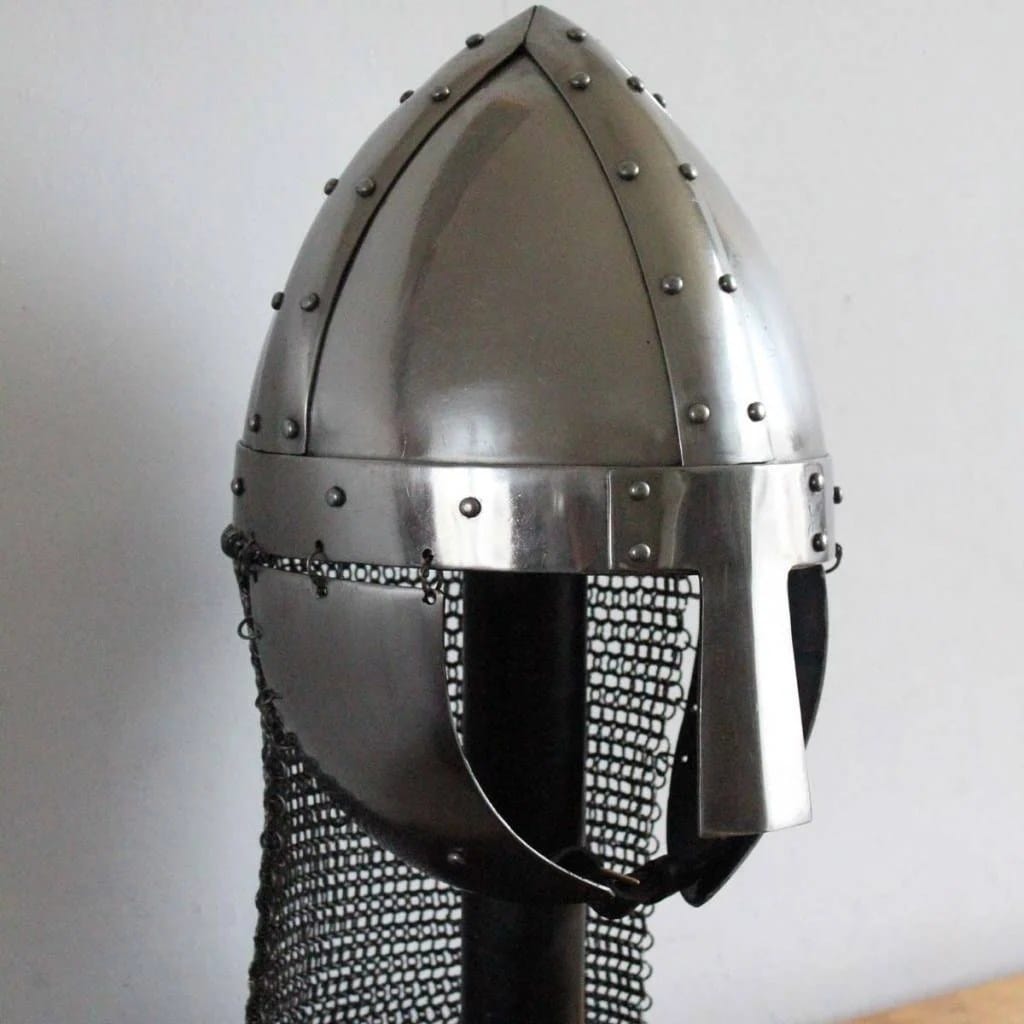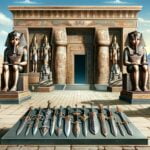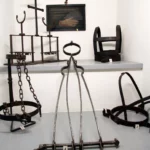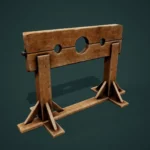This guide explores the fascinating history of the spangenhelm, a segmented helmet prominent in Late Antiquity and the Early Middle Ages. We’ll trace its origins, examine its construction, analyze its use in warfare, and discuss its lasting legacy.
Unveiling the Spangenhelm: Design and Construction
The spangenhelm gets its name from the German words spangen (clasps) and helm (helmet), perfectly describing its segmented construction. Skilled artisans crafted these helmets by joining metal plates (typically iron or steel, sometimes bronze) with reinforcing metal strips, the “spangen.” This clever technique created a conical helmet with surprising flexibility.
Deconstructing the Design
The spangenhelm’s signature conical shape likely aided in deflecting blows. Beyond the basic cone, many spangenhelms included additional features:
- Nasal Guard: A metal projection extending down from the brow provided crucial facial protection.
- Cheek Flaps: Metal or leather flaps offered added defense for the sides of the face.
- Mail Aventail: A curtain of interlocked metal rings attached to the lower edge protected the vulnerable neck area.
This modular design highlights the adaptability of the spangenhelm to different combat scenarios and individual preferences.
Tracing the Spangenhelm’s Origins: From Steppes to Europe
The spangenhelm’s story likely begins on the vast Eurasian steppes, home to nomadic Iranian tribes like the Scythians and Sarmatians. These skilled horsemen and warriors may have been among the first to develop and use this type of helmet. As these groups migrated westward, their innovative headgear traveled with them, influencing helmet designs across Europe and the Middle East. By the 6th century, the spangenhelm had become a ubiquitous piece of military equipment.
The Spangenhelm’s Spread and Influence
The spangenhelm’s widespread adoption across diverse cultures suggests both its practicality and effectiveness in combat. Its relatively simple construction, compared to some later helmet types, may also have contributed to its popularity. Representations of helmets in later artwork, such as the Bayeux Tapestry (11th century) and the Morgan Bible (13th century), hint at the spangenhelm’s lasting design influence. Discover the surprisingly similar shadufs used in ancient Egypt, demonstrating the spread of practical technologies across cultures.
The Spangenhelm in Battle: Protection and Limitations
The spangenhelm offered decent protection, particularly against glancing blows. The segmented design and the “spangen” themselves probably helped absorb and distribute the impact of a strike. However, it wasn’t without its weaknesses:
- Joint Vulnerabilities: The joints between the plates could be weak points, susceptible to well-aimed attacks.
- Partial Coverage: Unlike later helmets, the spangenhelm didn’t fully enclose the head, leaving areas exposed.
The Rise of New Designs
As warfare evolved, so did helmet technology. Newer designs, such as the nasal helm (think Norman knights) and the kettle hat, began to replace the spangenhelm. These later helmets provided increased protection and were better suited to changing combat styles. However, echoes of the spangenhelm’s conical shape and nasal guard can be seen in some of these successor designs, demonstrating its enduring legacy.
Did Vikings Wear Spangenhelms? Unraveling the Mystery
The question of Viking spangenhelm use is a complex one, filled with debate and ongoing research. While depictions in some Viking artwork and sagas suggest its presence, concrete archaeological evidence remains scarce. This lack of physical finds has led some experts to believe that spangenhelms were not commonly used by Vikings.
Exploring the Evidence
Several factors contribute to this uncertainty:
- Limited Archaeological Finds: The conditions in Viking burial sites may not be conducive to helmet preservation.
- Artistic Interpretation: Artistic representations may not be entirely accurate depictions of everyday Viking attire, potentially exaggerating the presence of helmets for symbolic purposes.
- Cultural Exchange: Even if not standard Viking equipment, the spangenhelm’s design may have influenced later Scandinavian helmet styles.
Ongoing Research
Further research, including new archaeological digs and advanced analytical techniques, is needed to shed more light on this intriguing question. Examining the materials and construction techniques of existing helmet fragments might reveal links to Viking craftsmanship. Detailed study of Viking art and literature could uncover subtle clues about helmet usage and design.
Who Wore the Spangenhelm? A Diverse Group of Warriors
The spangenhelm wasn’t limited to a single group. Its users spanned various cultures, time periods, and social classes:
- Nomadic Warriors: The Scythians and Sarmatians of the Eurasian steppes were likely among the earliest adopters.
- Infantry Soldiers: The spangenhelm provided essential protection for common foot soldiers in close combat.
- Elite Knights: Especially in the earlier medieval period, knights utilized the spangenhelm for mounted warfare.
A Symbol of Status and Cultural Exchange
Beyond its practical use, the spangenhelm may have held symbolic meaning for its wearers, potentially signifying status or group affiliation. Its journey from the Eurasian steppes to Europe highlights the exchange of ideas and technologies between nomadic and settled societies. Just as the spangenhelm spread across cultures, so did the scarab beetle’s meaning in ancient Egypt.
The Spangenhelm Today: A Legacy Forged in Metal and History
Although absent from modern battlefields, the spangenhelm has not been forgotten. Its distinctive appearance and historical significance ensure its continued presence in:
- Historical Reenactments: Enthusiasts recreate medieval battles and daily life, showcasing the spangenhelm in action.
- Media Portrayals: Movies, television shows, and video games utilize the spangenhelm to add authenticity to medieval settings.
The spangenhelm remains a powerful symbol of medieval warfare, capturing our imaginations centuries later. Ongoing research continues to reveal new insights into this intriguing piece of headgear, ensuring that its story continues to unfold.
| Feature | Description | Potential Benefit |
|---|---|---|
| Segmented Design | Metal plates joined by reinforcing strips (“spangen”) | Flexibility, comfortable wear, distributed impact absorption |
| Conical Shape | Sloping top | Deflection of blows |
| Nasal Guard | Optional metal piece protecting the nose and upper face | Additional facial protection |
| Materials | Typically iron or steel, sometimes bronze | Durability and protection |
| Construction | Skilled craftsmanship required for shaping, assembling, and finishing the components. | High-quality, reliable protection |
- Discover the Borough of Frenchtown, NJ: A Delaware River Town Blending History, Art & Nature - November 22, 2024
- Discover Clarks Grove, MN: A Small Town with a Big Heart - November 22, 2024
- Califon Borough, NJ: A Small Town with a Big Heart (and Rich History) - November 22, 2024













